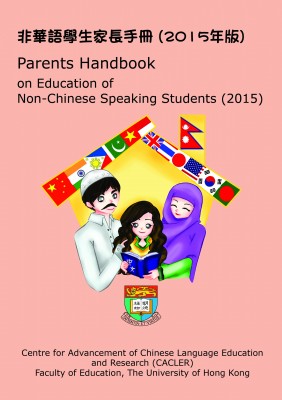This Parent Handbook is a deliverable of ‘University-School Support Programme: Supporting Secondary Schools in the Teaching and Learning of Chinese for non-native learners’ which is funded by Education Development Fund, Education Bureau.
Principal Investigator: Dr. Elizabeth Ka-yee LOH
Deputy Principal Investigator: Prof. Tse Shek-Kam
Co-Investigators: Dr. Mark Shiu-kee SHUM, Dr. Joseph Wai-ip LAM,
Dr. Lai Chun, Dr. Zhang Bennan, Ms. Ada Wan-man POON
This Parents Handbook on the education of non-Chinese Speaking Students was prepared by the Centre for Advancement of Chinese Language Education and Research (CACLER), Faculty of Education, the University of Hong Kong. It provides ethnic minority parents (hereafter referred to as “parents”) with useful information including Hong Kong’s education system, major education policies and services, educational opportunities and resources available for their children, as well as advice on how to communicate with schools for supporting their children’s learning.
Furthermore, this Handbook informs parents about planning their children’s educational path all the way from kindergarten to tertiary level. It also serves a platform for parents to express their expectations of their children, and for their children to share their experiences in learning Chinese as a second language in Hong Kong. A general introduction to the Cantonese dialect is provided towards the end of this Handbook as well.
In addition, contact information of community services and non-government organizations available to ethnic minority youth and parents is included for the readers’ convenience.
We hope that this Parents Handbook will enhance the mutual understanding and communication amongst ethnic minority parents, their children, local schools, the University and the community. Last but not least, we would like to take this opportunity to express our heartfelt thanks to all who have contributed to the completion of this Handbook.
We wish you all a successful career and wonderful life in Hong Kong.
Dr Joseph Wai-ip LAM
Associate Professor & Principal Investigator of the USP Project (2011-2013)
Faculty of Education
The University of Hong Kong
Dr Elizabeth Ka-yee LOH
Assistant Professor & Principal Investigator of the USP Project (2013-2015)
Faculty of Education
The University of Hong Kong
January 2015
| Preface | ||
| Introduction to the Handbook | p.1 | |
| Parents’ Voice
|
p.2-10
p.2 p.5 p.7 |
|
| Ethnic Minorities in Hong Kong | p.11-12 | |
| Communication with Schools
|
p.13-21
p.13 p.15 p.18 p.19 |
|
| Communication with Children
|
p.22 |
|
| Path to Success
|
p.28-33
p.28 p.30 |
|
| Community Resources
|
p.34-41
p.34 p.35 p.37 p.38 p.39 p.40 p.41 |
|
| Useful Information | p.42-47 | |
| Introduction to the Cantonese Dialect | p.48-56 | |
| Acknowledgements | p.57 |


